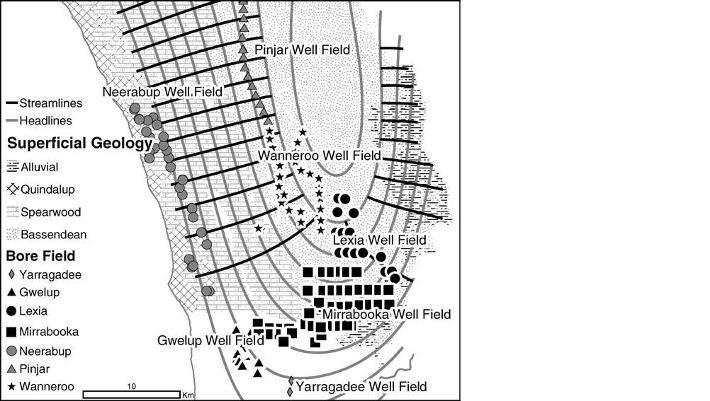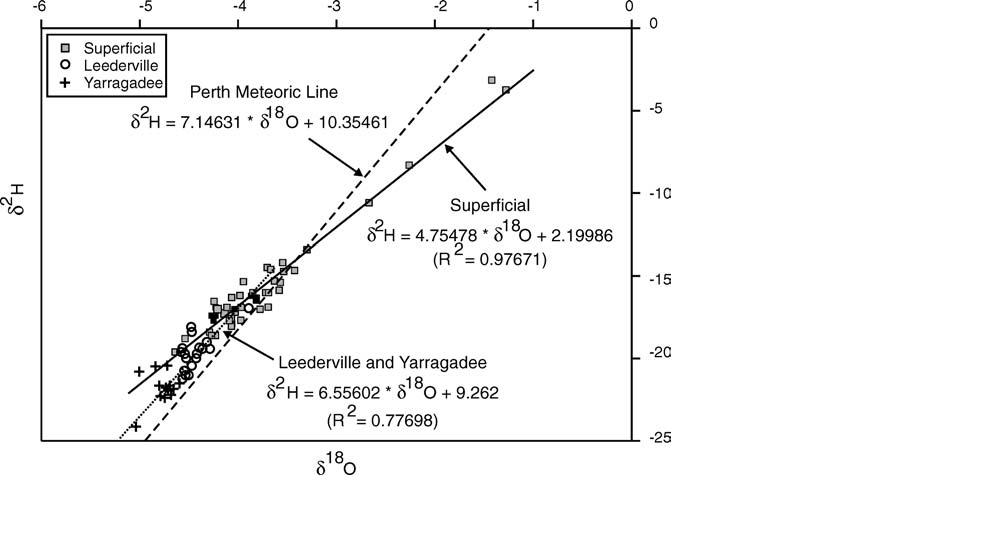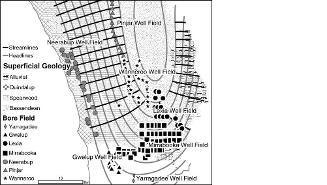
Fig 1. Gnangara Mound Well Fields showing location of sampled production wells






The Gnangara aquifers interconnectivity:
The geochemistry and stable isotope signatures of groundwater sampled from the three main aquifers; Superficial, Leederville and Yarragedee revealed distinct water types that suggest very little hydraulic connection or mixing of waters between the three aquifers. Groundwater in the Leederville aquifer is less than 36,000 years of age, whereas in the deeper Yarragadee
aquifer it is greater than 36,000 years of age. These dates suggest that recharge rates, particularly to the Yarragadee aquifer are low.
Groundwater recharge to the Leederville aquifer can take place where the confining Osborne Formation shale is absent, and the Leederville is in direct hydraulic connection with the Superficial aquifer and where the downward hydraulic gradient is significant. Similarly, groundwater recharge to the Yarragadee aquifer may occur through downward leakage of groundwater from the Leederville aquifer where the South Perth Shale is absent and downward hydraulic head prevails.
Although it was assumed by Davidson (1995) that recharge is taking place to the Leederville aquifer in the area where the aquifer is in direct hydraulic connection with the Superficial aquifer, the water quality and the isotopic signature data from this work, along with carbon dating from Thorpe and Davidson (1991), indicates that there is insignificance to no recent recharge to this aquifer.
It has also been postulated (Thorpe and Davidson, 1991) that oxygen–18 and deuterium composition of groundwater from the confined aquifers is almost constant, showing no systematic variation with groundwater age, and is similar to present day rainfall recharge. This suggests that groundwater recharge in this region during the Holocene and Late Pleistocene occurred under similar climatic conditions to
those of today. It was also suggested that groundwater discharges from the Leederville
aquifer into the Superficial aquifer where the Osborne Formation is absent and where upward head potentials occur along the western margin and offshore.
The isotopic signature from the production wells does not support this argument and indicates that the Leederville and Yarragadee aquifers were recharged during earlier cooler times, while the Superficial aquifer is being recharged at present.
The groundwater samples for this work were collected from production wells which are in operation and it is expected that the pumping regime would stress the aquifers and would cause mixing if the aquifers are interconnected. The only wells which are within this open window are the production wells along the Pinjar Line, and these do not show any mixing pattern at the moment. Only the wells along the
Neerabup line show some mixing with through-flow recharge water from the lakes.
Groundwater recharge to the Yarragadee aquifer was also assumed to take place by downward leakage of groundwater from the Leederville aquifer where the confining
layers are absent (Thorpe and Davidson, 1991). However, lower salinity in the northern Yarragadee in comparison to both the Leederville and the Superficial aquifer is an indication that there is no contemporary connection between these aquifers and also that filling up of the confined aquifers occurred during a cooler climatic period.
The isotopic signature from this work also shows the groundwater from the Yarragadee aquifer is highly depleted in comparison to the Leederville and Superficial aquifer waters, where each type of water plots in a distinctive zone. Carbon dating provided ages of more than 36,000 years for the Yarragadee and generally less than 36,000 years for the Leederville (Thorpe and Davidson, 1991). The span of 14C ages is such that some confined aquifer groundwaters would have been recharged during the Holocene and late Pleistocene glacial maximum (Turner and Thorpe, 2003). This indicates that there is no recent recharge to the Yarragadee and Leederville aquifers. Although some water samples examined here are in the mixing zone areas, this is most probably caused by well screens being located in mixed areas and/or mixing induced by pumping.
Possible future scenarios:
This poses the question: ‘will increasing discharge through groundwater pumping
and possible decrease in recharge enhance the interconnectivity?’
As previously mentioned, the only well field which is drilled in the window where the three aquifers are possibly interconnected is the Pinjar line. Although pumping is taking place from few wells along this well-field, the geochemical and isotopic signatures do not, as yet, show indications of mixing between the two waters.
It has also been postulated that recharge by downward leakage from the Superficial
aquifer will increase by pumping (Davidson, 1995). The decrease in recharge rates due to declining rainfall during the last decades, the increasing uptake of water by the introduced pine plantations, the ever-increasing withdrawal of groundwater from the aquifer in addition to the rising abstraction from the Leederville and
Yarragadee, as well as from the Superficial aquifer, will create differential heads which will most probably develop some connectivity. However this is unlikely to be associated with an increase in recharge to the deep aquifers, as the Superficial aquifer, from which recharge is supposed to take place is already being depleted and the pressures in the Leederville and Yarragadee aquifers are greatly reduced
by heavy pumping.